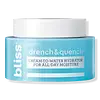What's inside
What's inside
 Key Ingredients
Key Ingredients

 Benefits
Benefits

 Concerns
Concerns

No concerns
 Ingredients Side-by-side
Ingredients Side-by-side

Water
Skin ConditioningCyclopentasiloxane
EmollientGlycerin
HumectantButylene Glycol
HumectantDimethicone
EmollientHydrogenated Polyisobutene
EmollientSodium Acetylated Hyaluronate
HumectantSodium Hyaluronate
HumectantSodium Hyaluronate Crosspolymer
HumectantHyaluronic Acid
HumectantEthylhexylglycerin
Skin ConditioningDimethicone/PEG-10/15 Crosspolymer
Sodium Chloride
MaskingPhenoxyethanol
PreservativeBenzyl Alcohol
PerfumingSodium Citrate
BufferingDimethicone/Vinyl Dimethicone Crosspolymer
Skin ConditioningChamomilla Recutita Flower Extract
MaskingPassiflora Incarnata Seed Oil
Skin ProtectingPotassium Sorbate
PreservativeGuar Hydroxypropyltrimonium Chloride
Skin ConditioningPolysorbate 20
EmulsifyingDipropylene Glycol
HumectantTetrahexyldecyl Ascorbate
AntioxidantTocopheryl Acetate
AntioxidantSilybum Marianum Seed Oil
Skin ConditioningCaprylic/Capric Triglyceride
MaskingPorphyra Umbilicalis Extract
Skin ConditioningTocopherol
AntioxidantCommiphora Mukul Resin Extract
Skin ConditioningSaccharina Longicruris Extract
HumectantRosa Multiflora Fruit Extract
MaskingSodium Benzoate
MaskingLinalool
PerfumingAlpha-Isomethyl Ionone
PerfumingLimonene
PerfumingParfum
MaskingWater, Cyclopentasiloxane, Glycerin, Butylene Glycol, Dimethicone, Hydrogenated Polyisobutene, Sodium Acetylated Hyaluronate, Sodium Hyaluronate, Sodium Hyaluronate Crosspolymer, Hyaluronic Acid, Ethylhexylglycerin, Dimethicone/PEG-10/15 Crosspolymer, Sodium Chloride, Phenoxyethanol, Benzyl Alcohol, Sodium Citrate, Dimethicone/Vinyl Dimethicone Crosspolymer, Chamomilla Recutita Flower Extract, Passiflora Incarnata Seed Oil, Potassium Sorbate, Guar Hydroxypropyltrimonium Chloride, Polysorbate 20, Dipropylene Glycol, Tetrahexyldecyl Ascorbate, Tocopheryl Acetate, Silybum Marianum Seed Oil, Caprylic/Capric Triglyceride, Porphyra Umbilicalis Extract, Tocopherol, Commiphora Mukul Resin Extract, Saccharina Longicruris Extract, Rosa Multiflora Fruit Extract, Sodium Benzoate, Linalool, Alpha-Isomethyl Ionone, Limonene, Parfum
Water
Skin ConditioningSqualane
EmollientGlycerin
HumectantPentylene Glycol
Skin ConditioningPolyglyceryl-2 Stearate
EmulsifyingGlyceryl Stearate
EmollientStearyl Alcohol
EmollientHyaluronic Acid
HumectantCeramide EOP
Skin ConditioningCeramide Ng
Skin ConditioningCeramide NP
Skin ConditioningCeramide As
Skin ConditioningCeramide AP
Skin ConditioningCarnosine
Skin ConditioningHydrogenated Lecithin
EmulsifyingPhytosterols
Skin ConditioningCaprylyl Glycol
EmollientPolyacrylate Crosspolymer-11
Emulsion Stabilising1,2-Hexanediol
Skin Conditioning
 Reviews
Reviews

Ingredients Explained
These ingredients are found in both products.
Ingredients higher up in an ingredient list are typically present in a larger amount.
Glycerin is already naturally found in your skin. It helps moisturize and protect your skin.
A study from 2016 found glycerin to be more effective as a humectant than AHAs and hyaluronic acid.
As a humectant, it helps the skin stay hydrated by pulling moisture to your skin. The low molecular weight of glycerin allows it to pull moisture into the deeper layers of your skin.
Hydrated skin improves your skin barrier; Your skin barrier helps protect against irritants and bacteria.
Glycerin has also been found to have antimicrobial and antiviral properties. Due to these properties, glycerin is often used in wound and burn treatments.
In cosmetics, glycerin is usually derived from plants such as soybean or palm. However, it can also be sourced from animals, such as tallow or animal fat.
This ingredient is organic, colorless, odorless, and non-toxic.
Glycerin is the name for this ingredient in American English. British English uses Glycerol/Glycerine.
Learn more about GlycerinHyaluronic acid is naturally found in healthy skin. It is a humectant, meaning it draws moisture to your skin.
This ingredient helps hydrate, soothe, and protect the skin.
What makes hyaluronic acid so hydrating? It has the capacity to bind or hold large amounts of water.
Fun fact: It is already naturally found in our bodies, such as the fluids of our eyes and our joints.
Studies find this ingredient to have anti-inflammatory and anti-microbial properties. This can help speed up wound-healing.
Hyaluronic acid can be irritating if the molecule has a low-molecular weight, or if the molecules are small.
One study found low-molecular weight hyaluronic acid to be pro-inflammatory, meaning some people may experience irritation. This is because our bodies use hyaluronic acid in the wound-healing process to signal to our bodies, via irritation, that something needs healing.
The same study found high-molecular weight hyaluronic acid to be anti-inflammatory.
These are some other common types of Hyaluronic Acid:
Learn more about Hyaluronic AcidWater. It's the most common cosmetic ingredient of all. You'll usually see it at the top of ingredient lists, meaning that it makes up the largest part of the product.
So why is it so popular? Water most often acts as a solvent - this means that it helps dissolve other ingredients into the formulation.
You'll also recognize water as that liquid we all need to stay alive. If you see this, drink a glass of water. Stay hydrated!
Learn more about Water